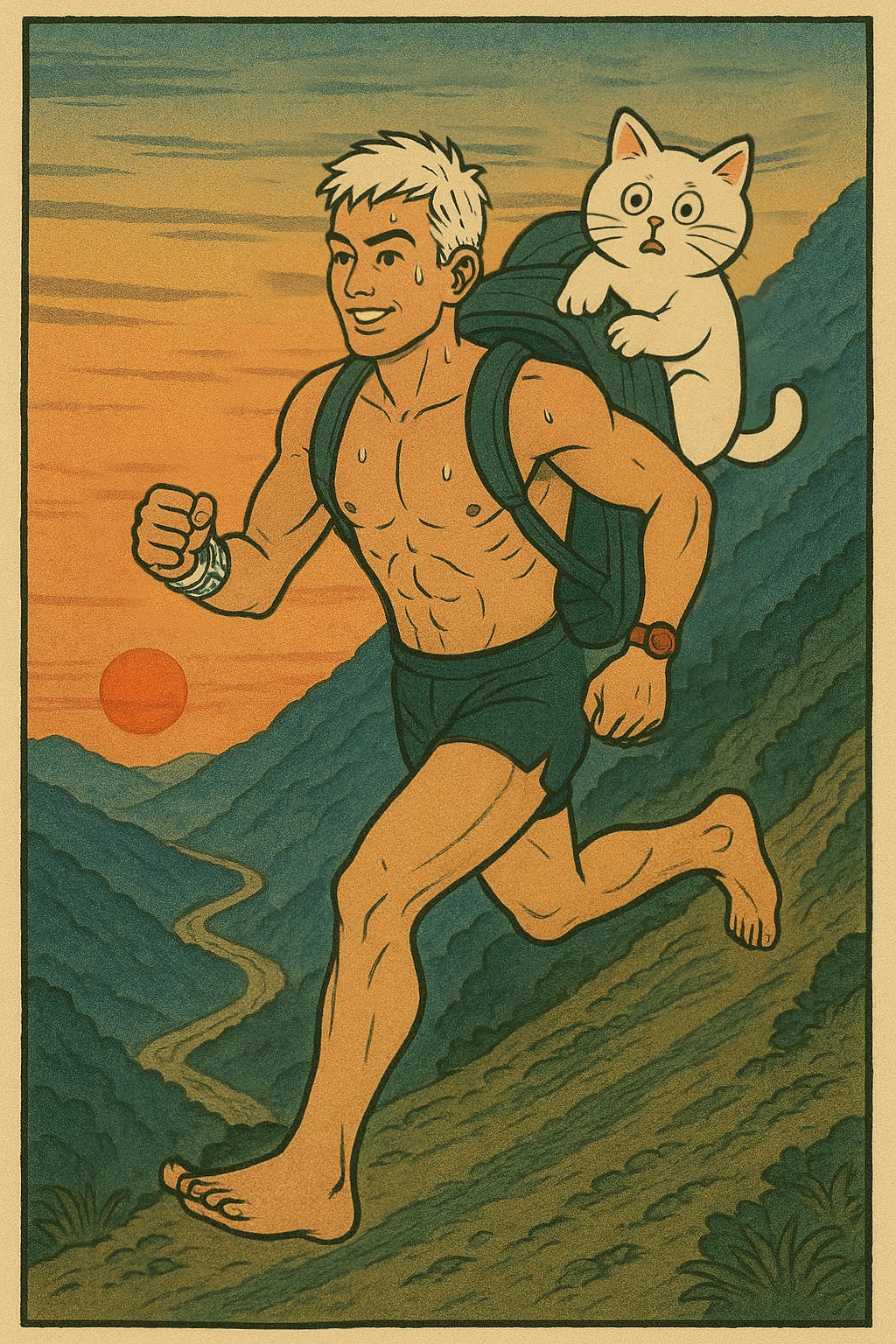It’s Not All Downhill from Here
A smarter road to staying strong, flexible, and sane.
The other morning, I was barefoot on a steep mountain road, carrying four yogurt bottles filled with water. I could feel them sloshing around a bit in my backpack - all 7.4 kilos of liquid effort - as I sprinted upward. Twenty seconds at a time, twice. That’s all.
If someone had told me in my twenties I’d be doing this after fifty… I’m not sure how I would’ve reacted, actually. Maybe I would have laughed. Fifty seemed like a lifetime away and well into what society thinks of as “senior years.” Back then, I thought aging meant decline. Knees wear out, joints stiffen, energy drops. That’s the script the society programs us to follow. After my knee injuries, I believed it even more. Running was out of the question, so was hiking. Sprinting uphill with a loaded backpack, barefoot, would’ve seemed like a suicidal mission to kill the knees once and for all.
Yet here I am, not broken, not fragile, but feeling like there’s a quiet monster purring inside. Powerful. Not reckless. Ready for action at a moment’s notice but not chasing numbers or personal records, just alive in movement. I also know when to stop. I don’t push past those twenty seconds, and I only do two sprints because I know the science. I know what works, and I know what breaks people. I’m also lazy, so I don’t do what gives me no extra benefit (the third sprint). What I do is enough to give me a heart that’s 20 years younger and more energy (mitochondria).
This is why the story about “aging as decline” falls apart. The truth is, if you haven’t been a lifelong athlete, you haven’t used up your body - and if you’re like me, you probably barely tapped into what it could do when you were younger.
People who’ve trained hard since youth often carry the cost. The same intensity that wins medals also grinds down cartilage, tears tendons, and pulls muscles. Many professional athletes live with chronic pain, joint replacements, or worse. They peaked early, but their “fitness” left scars. They also bemoan the lost power of their peak years.
The rest of us, the non-athletes, have a different kind of opportunity before us. We’re not trying to recover from overuse. We’re awakening systems that have been asleep, sometimes for decades. The muscles still know how to fire, the fascia still knows how to stretch, the joints still remember what fluid motion feels like. The potential is still in there. You just have to give your body the right treatment.
Not through punishment. Through gentle repetition. Through curiosity. Through the kind of movement that feels good enough to do again tomorrow, and the next day, and the day after that.
That’s the DSY principle: Don’t Strain Yourself. It’s not about taking it easy — it’s about not wasting effort on what hurts you. The right kind of effort compounds. You don’t need more willpower; you need better inputs.
Aging isn’t a steady slide down a hill. For many people, myself included, it’s actually the start of an upward curve. When you begin to move consistently, intelligently, and with awareness, you can improve faster than you think. Your body becomes lighter, your posture lifts, your breath deepens. You walk differently, sleep differently, feel different.
And it’s not discipline. It’s biology working the way it’s meant to. Movement feeds tissue. It signals repair, renews circulation, balances hormones. Every step, stretch, or sprint becomes a message to your body: stay alive, stay ready. Exercise is the most powerful health intervention you can do on yourself. If it were a pill, it would cost a lot of money and require a prescription. Right now, it only costs some effort - and far less than the fitness-industrial complex would have you believe.
That feeling I get in those twenty-second uphill runs - it’s not nostalgia. It’s not trying to recapture youth. It’s the opposite. It’s proof that growth doesn’t stop just because the calendar says so. It’s proof that strength, coordination, and grace can arrive late, and that they might even feel better and more precious now, because we understand the cost of losing them.
And that’s why it’s not downhill from here. Not if you learn how to move the way your body was built to move. Not if you give it the time, attention, and kindness it needs to rebuild. You can move better and be stronger than the 20-something you.
I share this because I know how many people give up too early. They believe the myth that fitness is for the young, that decline is inevitable. Or they fling themselves at gym machines with manic intensity that leaves them exhausted or injured, or both. Pain is not the price of age. You just have to find the smarter road. One that’s less traveled (because of all the unhelpful noise out there)… but there is a road mapped out by science and experience that doesn’t wreck you.
An Obligatory Plug for Myself 😜
If what I write about resonates with you and you’d like to build strength and flexibility without surrendering your life to the gym — I’m building a course to help you do exactly that. Support me on Buy Me a Coffee for $10 a month, and you’ll get access to the early material already live: the four-part Weeks Zero prep course and Weeks One, Two and Three, with more on their way.
Later, when the full program’s ready, it’ll be something you can buy. Right now, your support helps me build it.




Thank you. I hope the message eventually reaches those that need it. Adding life to your years 😜. I keep broadcasting the signal.
Pawel, this is an incredibly well-articulated and powerful article. You are capturing the problem and the solution. The opportunity! Thanks for your work!